活动介绍
管理会计CMA招生简章
公司简介

陕西业天勤企业管理咨询有限公司位于西安市碑林区互助路66号西部电力商务中心7楼E座,公司致力于管理会计领域的课程研发、课题研究、CMA体系培训、企业订制内训,帮助发展中的企业对经营业务进行控制,对业绩进行评价,强化企业内部经营管理,提高经济效益服务。公司主营业务:1.美国注册管理会计师(CMA)的考试培训2.管理会计领域内的企业内训。管理会计体系经典课程:全面预算管理、绩效管理、成本管理、内部控制、财务报表分析、公司理财、投融资决策分析、外部财务报告决策。欢迎广大企业高管莅临考察。
管理会计背景
未来会计行业的发展将是管理会计的大发展。一方面,当前中国经济发展的方向正从依靠大规模投资拉动的增长方式向资本节约型的高绩效管理模式进行转换,企业也越来越重视内部管理水平的提升和转型发展。会计在企业规划、决策、控制和评价等方面的作用越来越重要,企业的管理会计需求越来越高。另一方面,随着科技的发展、技术的进步,许多会计核算以及信息处理的工作可以由计算机替代,这样很多会计人员必然转向管理会计的相关工作。与此同时,财政部门基于我国当前管理会计发展不足的现状出台了相关指导意见,旨在全面推进我国管理会计体系建设。可以说,发展管理会计既是企业适应经济发展的内生需求,也是财政部推进我国会计工作转型升级的政策导向。
随着管理会计在企业实践的深度和广度持续加大,会计职能由核算到管理决策的转变将成为企业财会职能转型的重要内容。在这个过程中,会计人才是关键。
近年来,会计“考证热”一直持续,会计人才队伍越来越壮大。然而,当前我国会计人才的结构并不能满足企业对管理会计的需求。基础财会会计的供给越来越大,但是高端会计人才相对不足,管理会计人才更是匮乏。据统计,美国企业财会人员中从事管理会计的人占到90%,财会会计只有10%,管理会计人才75%以上的时间都用于决策性工作;日本松下公司财会部80%的人员都在做管理会计工作。而我国企业超过85%的财会人员都在做财会会计,其中80%以上的时间是用于会计账务记录和账务核算,管理会计人才缺口很大。

目标学员
1、企业内部财务专业人士:包括财务总监、财务经理、总账会计、财务分析等。
2、审计、会计及IT等专业机构人士:包括咨询顾问、会计师、税务师、资产评估师、系统方案解决经理、项目经理、SAP财务顾问等。
3、。投资机构人士:基金公司合伙人、投资总监、投资经理、财务分析专家、支行行长。
4、公司运营管理人士:包括人力资源总监、行政总监、市场营销总监、产品或运营总监、战略部门负责人、公司信息化负责人等。
5、企业战略管理人士:包括公司董事、董秘、公司总经理、公司合伙人、中国区首席代表、分公司负责人等。
6、如果你想从事财务工作,你想成为一名财务决策者,那么CMA就适合你。
课程理念
会管理 懂决策 善沟通
授课方式
课程通过项目教学、重点讲解、实操嫁接、案例精讲、习题串讲等环节使学员完全理解管理会计体系,嫁接管理会计链条,创新管理会计思路,快速有效的通过CMA考试,拿到证书,学以致用。

课程设置:
Certified Management Accountant (CMA) Examinations
注册管理会计师(CMA)考试内容大纲
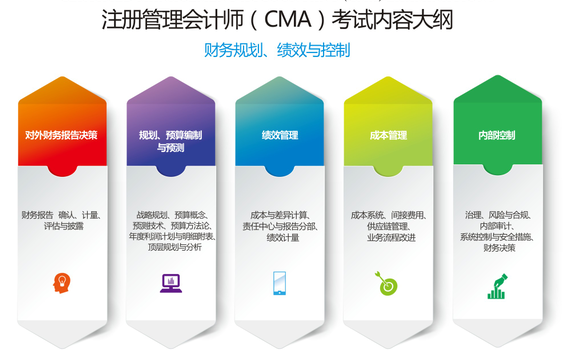
Part 1 - Financial Reporting, Planning, Performance, and Control
第一部分 -财务报告、计划、业绩考核和控制
A. External Financial Reporting Decisions (15%-Levels A, B, and C)
外部财务报告决策
1. Financial statements
财务报表
a. Balance sheet
资产负债表
b. Income statement
利润表
c. Statement of changes in equity
所有者权益变动表
d. Statement of cash flows
现金流量表
2. Recognition, measurement, valuation, and disclosure
确认,计量,计价和披露
a. Asset valuation
资产计价
b. Valuation of liabilities
负债计价
c. Equity transactions
权益性交易
d. Revenue recognition
收入确认
e. Income measurement
收益计量
f. Major differences between U.S. GAAP and IFRS
美国公认会计原则与国际财务报告准则的主要差异
B. Planning, Budgeting and Forecasting (30% - Levels A, B, and C)
计划、预算和预测 (30% - A、B和C级)
1. Strategic Planning
战略计划
a. Analysis of external and internal factors affecting strategy
分析影响战略的内部和外部因素
b. Long-term mission and goals
长期使命与目标
c. Alignment of tactics with long-term strategic goals
根据长期战略目标调整策略
d. Strategic planning models and analytical techniques
战略计划模型与分析技术
e. Characteristics of successful strategic planning process
成功的战略计划制定过程所具备的特性
2. Budgeting concepts
预算概念
a. Operations and performance goals
经营和业绩目标
b. Characteristics of a successful budget process
成功的预算编制过程所具备的特性
c. Resource allocation
资源分配
d. Other budgeting concepts
其他预算概念
3. Forecasting techniques
预测技术
a. Regression analysis
回归分析
b. Learning curve analysis
学习曲线分析
c. Expected value
期望值
4. Budgeting methodologies
预算方法
a. Annual business plans (master budgets)
年度企业计划(总预算)
b. Project budgeting
项目预算
c. Activity-based budgeting
作业预算编制
d. Zero-based budgeting
零基预算法
e. Continuous (rolling) budgets
连续(滚动)预算
f. Flexible budgeting
弹性预算
5. Annual profit plan and supporting schedules
年度利润计划和附表
a. Operational budgets
营业预算
b. Financial budgets
财务预算
c. Capital budgets
资本预算
6. Top-level planning and analysis
顶层规划与分析
a. Pro forma income
预计损益表
b. Financial statement projections
预计财务报表
c. Cash flow projections
预计现金流量
C. Performance Management (20% - Levels A, B, and C)
业绩管理 (20% - A、B和C级)
1. Cost and variance measures
成本与差异核算
a. Comparison of actual to planned results
实际与计划成果比较
b. Use of flexible budgets to analyze performance
使用弹性预算分析业绩
c. Management by exception
例外原则管理
d. Use of standard cost systems
标准成本系统的使用
e. Analysis of variation from standard cost expectations
对预期的标准成本的差异分析
2. Responsibility centers and reporting segments
责任中心和报告部门
a. Types of responsibility centers
责任中心的种类
b. Transfer pricing models
转移价格定价模式
c. Reporting of organizational segments
组织各部门的报告书
3. Performance measures
业绩考核
a. Product profitability analysis
产品获利能力分析
b. Business unit profitability analysis
经营单位获利能力分析
c. Customer profitability analysis
客户获利能力分析
d. Return on investment
投资回报率
e. Residual income
剩余收益
f. Investment base issues
投资基准问题
g. Key performance indicators (KPIs)
关键绩效指标
h. Balanced scorecard
平衡记分卡
D. Cost Management (20% - Levels A, B, and C)
成本管理 (20% - A、B和C级)
1. Measurement concepts
计量概念
a. Cost behavior and cost objects
成本习性和成本对象
b. Actual and normal costs
实际成本和正常成本
c. Standard costs
标准成本
d. Absorption (full) costing
吸收(全部)成本法
e. Variable (direct) costing
变动(直接)成本法
f. Joint and by-product costing
联产品和副产品成本法
2. Costing systems
成本计算制度
a. Job order costing
分批成本法
b. Process costing
分步成本法
c. Activity-based costing
作业成本法
d. Life-cycle costing
生命周期成本法
3. Overhead costs
间接成本
a. Fixed and variable overhead expenses
固定和变动间接费用
b. Plant-wide versus departmental overhead
全厂间接费用和部门(车间)间接费用
c. Determination of allocation base
分配基础的确定
d. Allocation of service department costs
服务部门成本的分配
4. Supply Chain Management
供应链管理
a. Lean manufacturing
精益生产
b. Enterprise resource planning (ERP)
企业资源计划
c. Theory of constraints and throughput costing
约束理论和产量成本法
d. Capacity management and analysis
产能管理和分析
5. Business process improvement
业务流程改进
a. Value chain analysis
价值链分析
b. Value-added concepts
增值概念
c. Process analysis
流程分析
d. Activity-based management
作业管理
e. Continuous improvement concepts
持续改进概念
f. Best practice analysis
最佳方法分析
g. Cost of quality analysis
质量成本分析
h. Efficient accounting processes
高效的会计流程
E. Internal Controls (15% - Levels A, B, and C)
内部控制 (15% - A、B和C级)
1. Governance, risk, and compliance
管理,风险与法规遵守
a. Internal control structure and management philosophy
内部的控制结构和管理理念
b. Internal control policies for safeguarding and assurance
保护和担保的内部控制政策
c. Internal control risk
内部控制风险
d. Corporate governance
公司管理
e. External audit requirements
外部审计规要
2. Internal auditing
内部审计
a. Responsibility and authority of the internal audit function
内部审计职能的责任和权力
b. Types of audits conducted by internal auditors
内部审计师进行审计的类型
3. Systems controls and security measures
系统控制和安全措施
a. General accounting system controls
普通会计系统控制
b. Application and transaction controls
应用控制和交易控制
c. Network controls
网络控制
d. Backup controls
安全备份管控
e. Business continuity planning
业务连续性计划
Part 2- Financial Decision Making
第二部分—财务决策
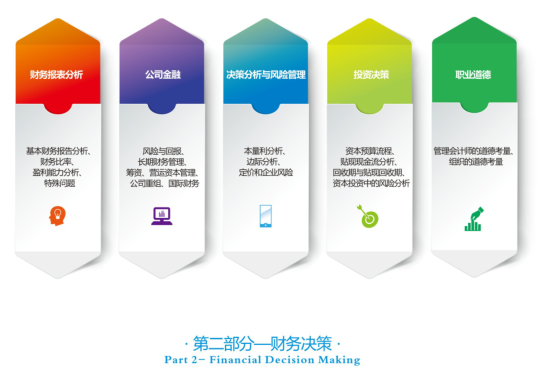
A. Financial Statement Analysis (25% - Levels A, B, and C)
财务报表分析 (25% - A、B和C级)
1. Basic Financial Statement Analysis
基本财务报表分析
a. Common size financial statements
同比财务报表b. Common base year financial statements
共同基年财务报表
2. Financial Ratios
财务比率
a. Liquidity
流动性(变现能力)
b. Leverage
杠杆
c. Activity
活动性
d. Profitability
获利能力
e. Market
市场
3. Profitability analysis
获利能力分析
a. Income measurement analysis
收益计量分析
b. Revenue analysis
收入分析
c. Cost of sales analysis
销货成本分析
d. Expense analysis
费用分析
e. Variation analysis
差异分析
4. Special issues
特殊问题
a. Impact of foreign operations
国外业务影响
b. Effects of changing prices and inflation
物价变动和通货膨胀的影响
c. Off-balance sheet financing
资产负债表外融资
d. Impact of changes in accounting treatment
会计处理方法变更的影响
e. Accounting and economic concepts of value and income
价值与收益的会计和经济概念
f. Earnings quality
盈余质量
B. Corporate Finance (20% - Levels A, B, and C)
公司财务 (20% - A、B和 C级)
1. Risk and return
风险和报酬
a. Calculating return
计算回报率
b. Types of risk
风险类型
c. Relationship between risk and return
风险与回报之间的关系
2. Long-term financial management
长期财务管理
a. Term structure of interest rates
利率期限结构
b. Types of financial instruments
金融工具的种类
c. Cost of capital
资本成本
d. Valuation of financial instruments
对金融工具的计价
3. Raising capital
筹集资本
a. Financial markets and regulation
金融市场与法规
b. Market efficiency
市场效率
c. Financial institutions
金融机构
d. Initial and secondary public offerings
首次公开募股与二次发行
e. Dividend policy and share repurchases
股息政策和股份回购
f. Lease financing
租赁融资
4. Working capital management
营运资本管理
a. Working capital terminology
营运资金(营运资本)术语
b. Cash management
现金管理
c. Marketable securities management
有价证券管理
d. Accounts receivable management
应收账款管理
e. Inventory management
存货管理
f. Types of short-term credit
短期信贷种类
g. Short-term credit management
短期信贷管理
5. Corporate restructuring
公司重组
a. Mergers and acquisitions
合并与收购
b. Bankruptcy
破产
c. Other forms of restructuring
其他重组形式
6. International finance
国际金融
a. Fixed, flexible and floating exchange rates
固定、弹性和浮动汇率
b. Managing transaction exposure
交易风险管理
b. Financing international trade
国际贸易融资
d. Tax implications of transfer pricing
转移定价的税金影响
C. Decision Analysis (20% - Levels A, B, and C)
决策分析 (20% - A、B和 C级)
1. Cost/volume/profit analysis
成本/数量/利润分析
a. Breakeven analysis
保本分析
b. Profit performance and alternative operating levels
盈利业绩和营业水平的改变
c. Analysis of multiple products
多产品的分析
2. Marginal analysis
边际分析
a. Sunk costs, opportunity costs and other related concepts
沉没成本、机会成本和其他相关的概念
b. Marginal costs and marginal revenue
边际成本和边际收入
c. Special orders and pricing
特别定单和定价
d. Make versus buy
自制或外购决策
e. Sell or process further
销售或进一步加工
f. Add or drop a segment
添设或终止一个部门
g. Capacity considerations
产能考虑
3. Pricing
定价
a. Pricing methodologies
定价方法
b. Target costing
目标成本法
c. Elasticity of demand
需求弹性
d. Product life cycle considerations
产品寿命周期的考量
e. Market structure considerations
市场结构因素的考量
D. Risk Management (10% - Levels A, B, and C)
风险管理 (10% - A、B和 C级)
1. Enterprise risk
企业风险
a. Types of risk
风险的类型
b. Risk identification and assessment
风险的确定和评估
c. Risk mitigation strategies
风险缓解策略
d. Managing risk
风险管理
E. Investment Decisions (15% - Levels A, B, and C)
投资决策 (15% - A、B和C级)
1. Capital budgeting process
资本预算过程
a. Stages of capital budgeting
资本预算的步骤
b. Incremental cash flows
递增现金流
c. Income tax considerations
所得税因素
2. Discounted cash flow analysis
现金流折现分析
a. Net present value
净现值
b. Internal rate of return
内部回报率
c. Comparison of NPV and IRR
净现值和内部回报率的比较
3. Payback and discounted payback
投资回收期与折现投资回收期
a. Uses of payback method
投资回收期法的应用
b. Limitations of payback method
投资回收期法的局限性
c. Discounted payback
折现投资回收期
4. Risk analysis in capital investment
资本投资的风险分析
a. Sensitivity and scenario analysis
敏感性分析和情景分析
b. Real options
实际选择权
F. Professional Ethics (10% - Levels A, B, and C)
职业道德 (10% - A、B和 C级)
1. Ethical considerations for management accounting and financial management professionals
管理会计和财务管理专业人士的职业道德注意事项
a. IMA’s “Statement of Ethical Professional Practice”
IMA“职业道德守则公告”
b. Fraud triangle
舞弊三角
c. Evaluation and resolution of ethical issues
职业道德问题的评估和解决方案
2. Ethical considerations for the organization
组织对道德的考虑
a. IMA’s Statement on Management Accounting, “Values and Ethics: From Inception to Practice”
IMA管理会计公告“价值观和道德规范:从确立到实践”
b. U.S. Foreign Corrupt Practices Act
美国《反海外贪腐法》
c. Corporate responsibility for ethical conduct
公司对道德操守的责任
证书获得
通过考试,取得证书。
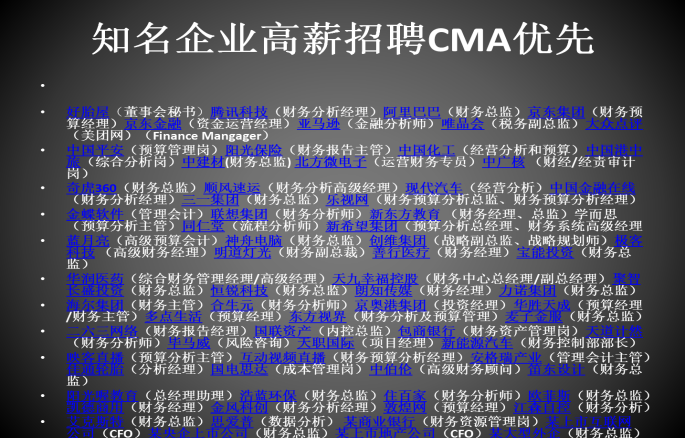
学制、学费及上课地点
1、 学制
学制二年(线上),学制一年(线下),沙龙一年(线下)
2、 学费
全程学习费用:16800元/人
3、 上课地点:线上考证,线下实操+沙龙
缴费方式
开户单位:陕西业天勤企业管理咨询有限公司
开户行:中国银行股份有限公司西安互助路支行
账号:1024 6832 9155
用途:培训费
报名资料
1、 填写申请表一式两份或电子版
2、 最高学历证书的复印件二份
3、 身份证复印件二份
4、 一寸、二寸彩色近照各两张
报名联系
联系人:029-83229999 徐老师
报名地址:西安市互助路66号西部电力国际商务中心7层E座
往期精彩
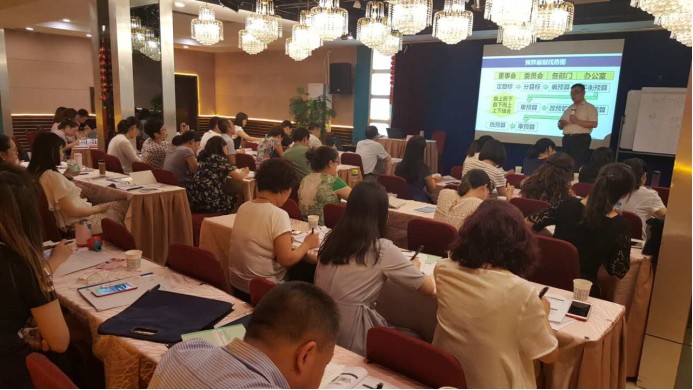
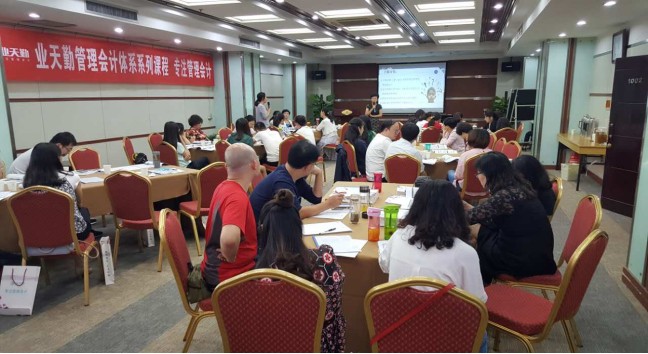

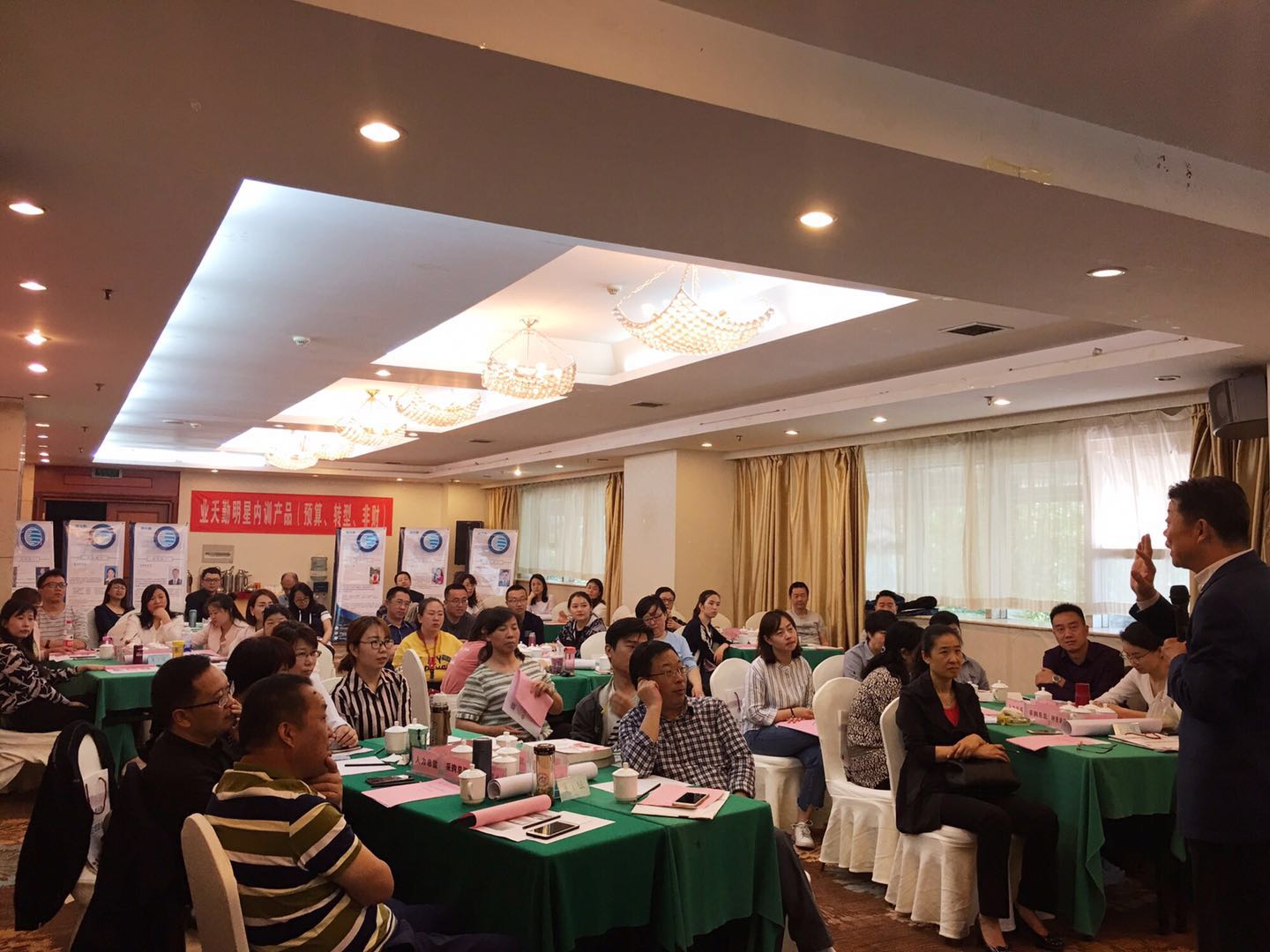

更多内容请关注本平台公众号 !!!
CMA项目经理
【联系人】徐爱华
【咨询】029-83229999【微信】15029927065

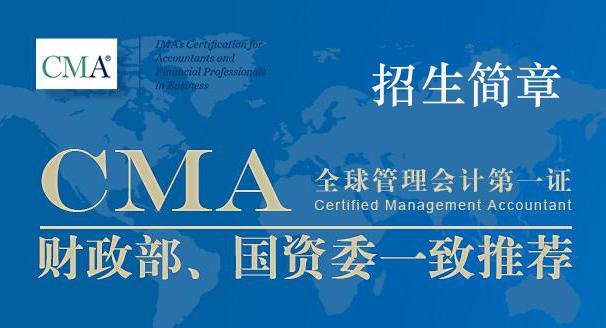
 2018年05月29日 - 12月31日
2018年05月29日 - 12月31日 付费
付费  教育培训
教育培训

